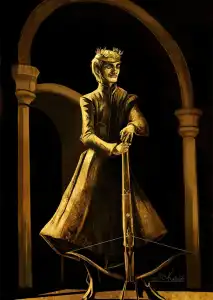Chapter 77: Preparing the Tercio |
After recruiting a legend like Frundsberg, of course Marin was happy. Because to have the “Father of Mercenaries” as his own muscleman, it was an extremely prideful thing regardless. With the existence of Frundsberg, Marin started actually testing the true Tercio.
When he was training the infantry phalanx, Marin felt like there was a great flaw in it. The greatest problem was, that they could do nothing against plate armor. For example, in the ambush of Fornovo, Marin helplessly realized that the thousands of French knights in plated armor died mostly because of being crushed by rocks, or were pushed down the mountain with spears and fell to their deaths. As for the ones who were stabbed to death by spears, or shot by arrows, the total doesn’t exceed 50.
Which also means, that the previous infantry phalanx was only suited to knock down those fancy-dressed Swiss mercenaries. When faced against the French knights who liked wearing plate armor, they were actually helpless. Of course, if the French knights were charging the phalanx on warhorses, that would be another matter. If I can’t stab the knights who are fully covered like a ‘tincan’ to death, you think I can’t stab the warhorses to death?
One must know, horse barding and human plate armor was different. In comparison, the coverage of horse barding was much worse than plate armor, as it was only slapped onto the horse’s back and head. On its legs, there were no armor. Because the horses needed to run, if it was fully covered in armor, then it wouldn’t be able to gallop.
Besides, horse barding was mainly made with lamellar armor, specifically for it to be convenient for running. Plate armor was too restrictive of movement. Once putting that on, a person would start moving like a robot. If a horse started wearing plate armor, then it would also be unable to run.
As for spears, against the lamellar armor covering the horses, it was still lethal and could penetrate through. Even if it couldn’t pierce through the barding, they could also lower the position to stab the legs or stomach of the horse not covered by the armor.
That’s why, having heavy knight units on horses to charge through this phalanx was actually really detrimental…
However, it’s not to say that knights had no solutions for the spear array. If the knights abandoned their horses and walked, and charged through the spear array just like that, they would have a great time. Because if both sides have a stabbing contest, the average mercenary wasn’t wearing any armor at all, while the knights were in plate armor. One side would be afraid of blows, and would die with one blow, while the other was covered in plate armor, and wasn’t afraid of stabs, so if they had a stabbing contest, isn’t the result easy to see?
As for the archers in Marin’s original phalanx, they were also quite helpless when facing against knights in full plate armor. When arrows hit the plate armors made from iron plates, they couldn’t penetrate it, at the most leaving behind deep marks. Even if they manage to hit a joint, that would only injure the enemy, and was not at all lethal…
In the early days, the reason why the Tercio was so strong, was because they used Spanish muskets in large quantities. That was a type of heavy arquebus, reaching a weight of 10 kilograms, which was twice heavier than the arquebuses. Accordingly, its caliber was much greater, and the bullet was heavier, reaching 50 grams.
Once a 50 gram lead ball was fired out of the arquebus, it would travel at subsonic speed at several hundred meeters per second, once it impacts the knight wearing plate armor, aside from a strong amount of kinetic energy, there would also be a strong shockwave. Under the impact of such a strong force, the knights either fall off their horses and get injured, or just die outright. Even if it hits the horse’s body, it wouldn’t be fine.
If it enters the body, a large lead ball weighing 50 grams, the injury it would cause… as well as the rolling effect of the ball… hehe… they could start preparing for their funeral immediately, as there was no way to save them…
Besides, at the end of the 15th century and start of the 16th century, due to the underdeveloped smelting technology, only heavy firearms like the Spanish musket could ensure that the barrel wouldn’t blow up. If they made it smaller and thinner, like the pistols of Ming, which weighed about 5 catty, before they kill the enemies, they would’ve killed themselves first…
Precisely because the Tercio utilized muskets in great quantities, which made the phalanx not only great in melee combat, but also having a strong ranged attack, especially against plate armor knights, who cared if they were on horseback or on-foot. That’s why, the Spaniards managed to rampage through the European continent for more than a century with that phalanx, which also forced knights in plate armor off the worldstage. Afterwards, Johann Tserclars von Tilly, the Count of Tilly, also relied on the Tercio, and managed to fight his way up from a nobody to a Count, until he encountered the more badass Gustavus Adolphus.
During the entirety of 16th century, the Tercio was the most badass phalanx of Europe — until the emergence of Maurice, who reformed the Spanish tercio and gave birth to the Maurice phalanx…
In a nutshell, the Tercio, would be an impossible challenge for the current armies of Europe. They could give the French knights a run for their money as well as bully the Swiss spearmen.
In truth, before the Italian war has broke out, Marin had wanted to establish the tercio. However, he was short on time and did not have time to seek out suitable firearms, neither did he have sufficient funds to purchase firearms and ammunition. That’s why, he could only replace them with archers for the time being.
But the Italian war had made him realize that the enemies would not act as he wanted, to arrange suitable enemies for him. The archers could do nothing against the knights in plate amror, all they could do was damage the unarmored infantry. But the enemies wouldn’t send unarmored infantry to their deaths without doing anything, they might even just send out plate armor knights who can’t be taken down with arrows. That’s why, owning firearms would be the better choice.
Besides, gunners were much easier to train, after a week or two of training, they could be dragged into the battlefield. While an archer would have to be trained for dozens of years…
Of course, Marin himself actually wasn’t that fond of the Tercio. He personally liked Gustavus Adolphus’ phalanx even better. However, since he was fighting for the Emperor, Marin was unwilling to show his strongest formation. Even by pulling out the tercio, it would already be more than enough to stomp on the French knights and Swiss spearmen. As for Frundsberg, he was the commander of Tercio in Marin’s eyes. When the Emperor requires, he’ll have this lad lead the Tercio, and have a fight to the death with the enemies. With Frundsberg’s talents, and the technological advancement of the Tercio, he would have no problem rampaging throughout Western Europe. As for the next enemy of Maximillian the First, they’re mainly the Swiss (Swabian war), French (Italian war) and Hungarians. The Tercio was absolutely more than sufficient.
As for the chain of command for the phalanx, the basic officers, Marin intends to pick them amongst his 400 underlings, regardless if it was the company captain or squad leader.
The families of these men have been relocated onto Texel, so they must share his responsibility. In that case, the formation of the new army would definitely still remain within his hands. As for Frundsberg, Marin had feeled him out, it appears like he was purely a martial officer, and his ability for political warfare was average, it should be difficult for him to escape his grasp. After all, the reason Marin recruited Frundsberg was to have him work under the Emperor in his stead, so he couldn’t find someone rebellious.
Marin did not care much about other things, all he cared was his own utility in Maximillian the First’s eyes. If Frundsberg usurped his army and joined the Emperor directly, then his own importance would go down. And he was already on bad terms with the Old Nobles. If he loses the Emperor’s support now, he would have a difficult time navigating out of this.
With Frundsberg’s addition, Marin had finally decided to form the Tercio. As for the lack of men, Marin was not concerned. Because after the success of the Italian war, many young men of Deutsche Germany were willing to become a mercenary.
Aside from that, it seems that the authentic Tercio had prepared Maximillian Armor for the upper bodies of the frontline soldiers, as well as Spanish-styled helmets, in order to increase their odds of survival.
As such, Marin had decided to also outfit his soldiers with body armor and helmets, to increase the soldiers’ survivability. In order to arm them with armor, Marin had decided to send people to the Southern parts of Deutsche Germany, to recruit proficient armorsmiths, to produce amor and helmets specifically for the soldiers.
Lastly, the classic weapon of the Tercio — muskets. Those things were currently under the sole possession of the Spanish, and have not been put through actual combat. Marin decided — send someone to Spain, have them recruit Spanish artisans who were experts at making muskets, to have them make firearms for him, and supply the needs of the army…

















